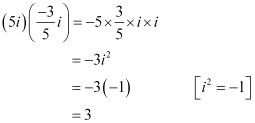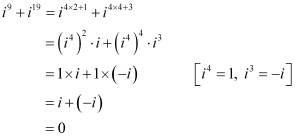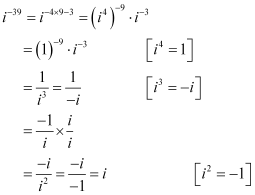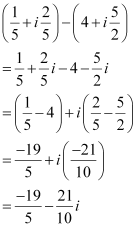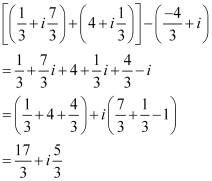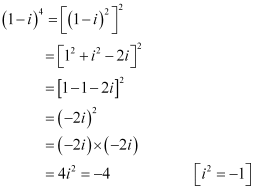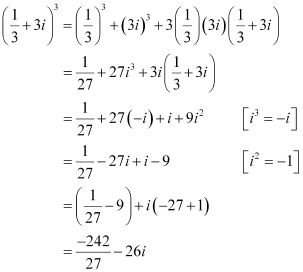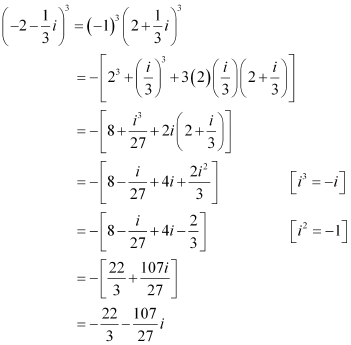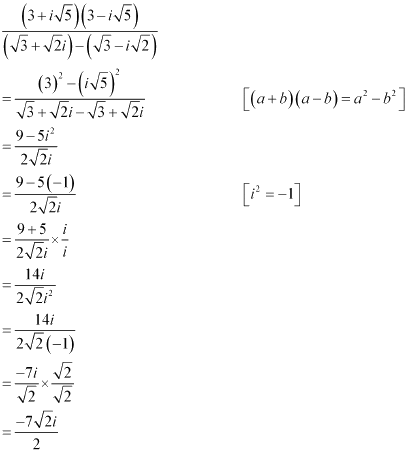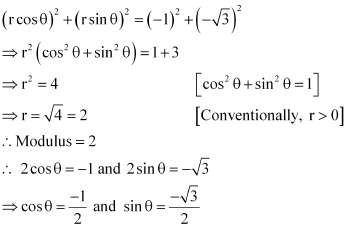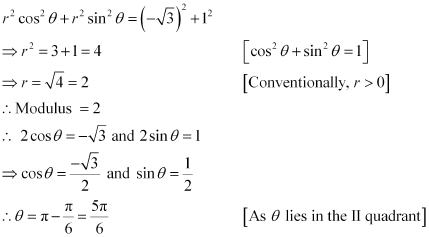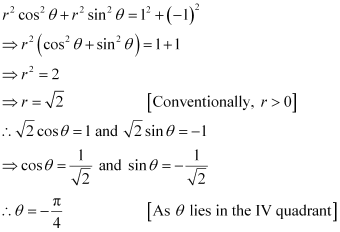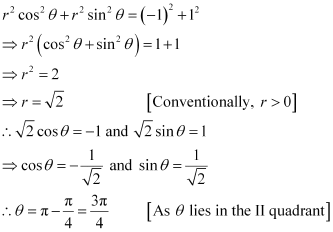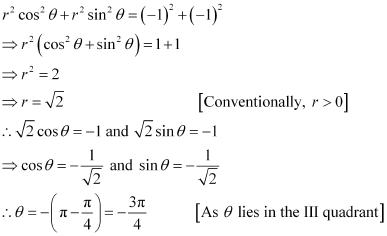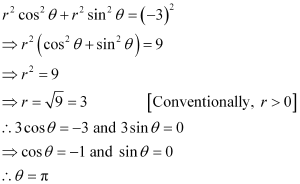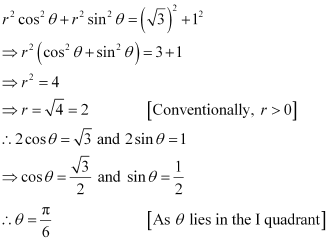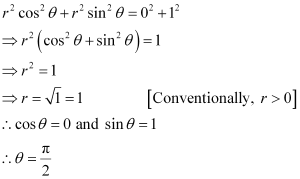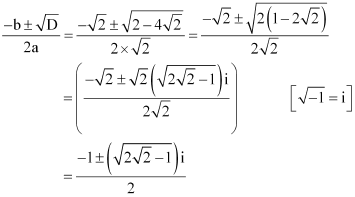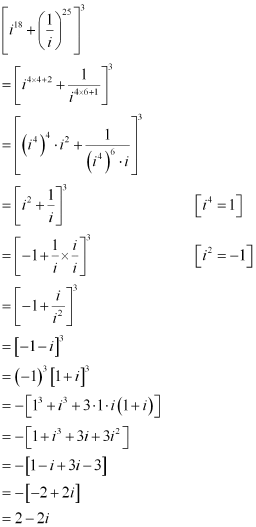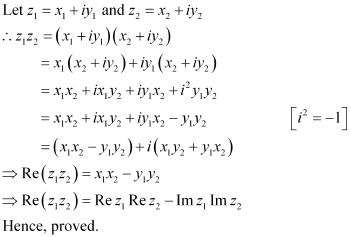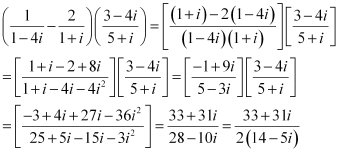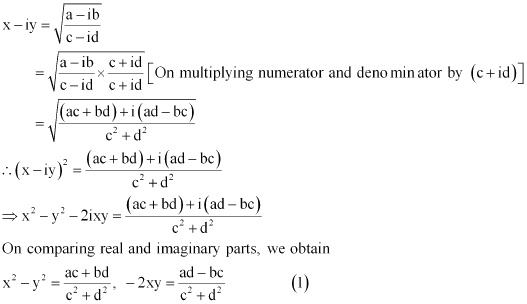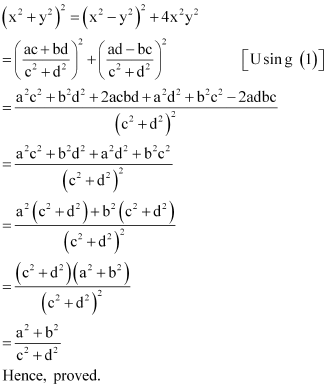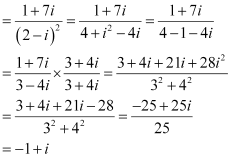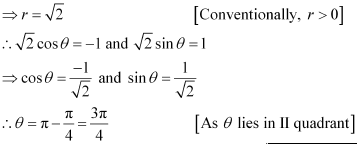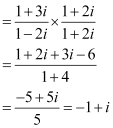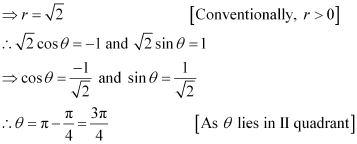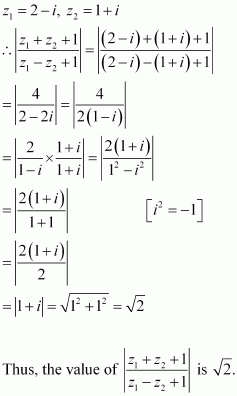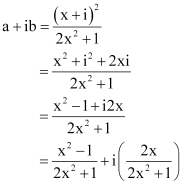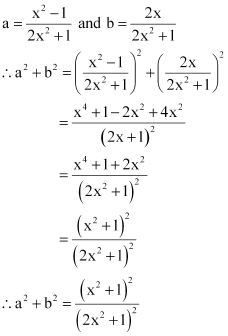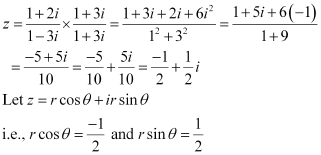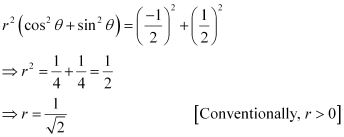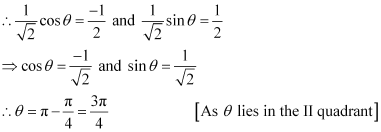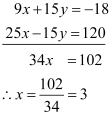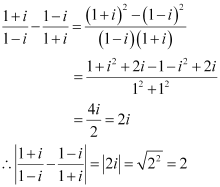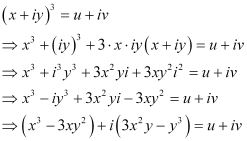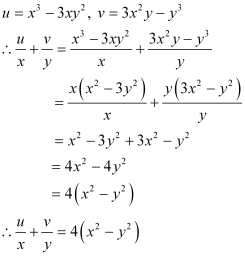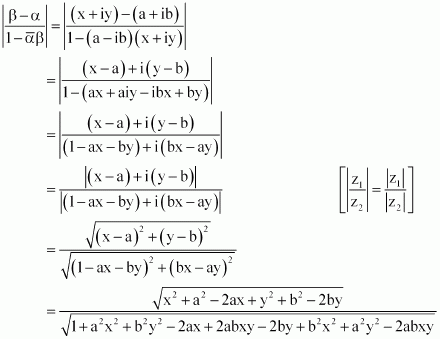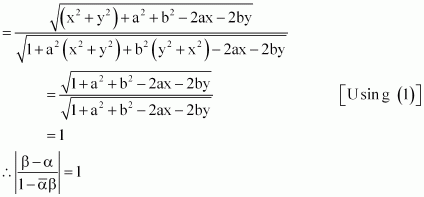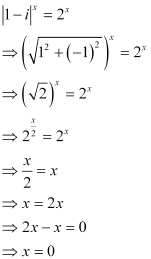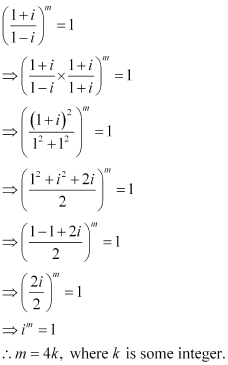NCERT Solutions for Class 11 Maths Chapter 5 – Complex Numbers And Quadratic Equations
Page No 103:
Question 1:
Express the given complex number in the form a + ib:
ANSWER:
Page No 103:
Question 2:
Express the given complex number in the form a + ib: i9 + i19
ANSWER:
Page No 103:
Question 3:
Express the given complex number in the form a + ib: i–39
ANSWER:
Page No 104:
Question 4:
Express the given complex number in the form a + ib: 3(7 + i7) + i(7 + i7)
ANSWER:
Page No 104:
Question 5:
Express the given complex number in the form a + ib: (1 – i) – (–1 + i6)
ANSWER:
Page No 104:
Question 6:
Express the given complex number in the form a + ib:
ANSWER:
Page No 104:
Question 7:
Express the given complex number in the form a + ib:
ANSWER:
Page No 104:
Question 8:
Express the given complex number in the form a + ib: (1 – i)4
ANSWER:
Page No 104:
Question 9:
Express the given complex number in the form a + ib:
ANSWER:
Page No 104:
Question 10:
Express the given complex number in the form a + ib:
ANSWER:
Page No 104:
Question 11:
Find the multiplicative inverse of the complex number 4 – 3i
ANSWER:
Let z = 4 – 3i
Then, = 4 + 3i and
Therefore, the multiplicative inverse of 4 – 3i is given by
Page No 104:
Question 12:
Find the multiplicative inverse of the complex number
ANSWER:
Let z =
Therefore, the multiplicative inverse ofis given by
Page No 104:
Question 13:
Find the multiplicative inverse of the complex number –i
ANSWER:
Let z = –i
Therefore, the multiplicative inverse of –i is given by
Page No 104:
Question 14:
Express the following expression in the form of a + ib.
ANSWER:
Page No 108:
Question 1:
Find the modulus and the argument of the complex number
ANSWER:
On squaring and adding, we obtain
Since both the values of sin θ and cos θ are negative and sinθ and cosθ are negative in III quadrant,
Thus, the modulus and argument of the complex number are 2 and
respectively.
Page No 108:
Question 2:
Find the modulus and the argument of the complex number
ANSWER:
On squaring and adding, we obtain
Thus, the modulus and argument of the complex number are 2 and
respectively.
Page No 108:
Question 3:
Convert the given complex number in polar form: 1 – i
ANSWER:
1 – i
Let r cos θ = 1 and r sin θ = –1
On squaring and adding, we obtain
This is the required polar form.
Page No 108:
Question 4:
Convert the given complex number in polar form: – 1 + i
ANSWER:
– 1 + i
Let r cos θ = –1 and r sin θ = 1
On squaring and adding, we obtain
It can be written,
This is the required polar form.
Page No 108:
Question 5:
Convert the given complex number in polar form: – 1 – i
ANSWER:
– 1 – i
Let r cos θ = –1 and r sin θ = –1
On squaring and adding, we obtain
This is the required polar form.
Page No 108:
Question 6:
Convert the given complex number in polar form: –3
ANSWER:
–3
Let r cos θ = –3 and r sin θ = 0
On squaring and adding, we obtain
This is the required polar form.
Page No 108:
Question 7:
Convert the given complex number in polar form:
ANSWER:
Let r cos θ = and r sin θ = 1
On squaring and adding, we obtain
This is the required polar form.
Page No 108:
Question 8:
Convert the given complex number in polar form: i
ANSWER:
i
Let r cosθ = 0 and r sin θ = 1
On squaring and adding, we obtain
This is the required polar form.
Page No 109:
Question 1:
Solve the equation x2 + 3 = 0
ANSWER:
The given quadratic equation is x2 + 3 = 0
On comparing the given equation with ax2 + bx + c = 0, we obtain
a = 1, b = 0, and c = 3
Therefore, the discriminant of the given equation is
D = b2 – 4ac = 02 – 4 × 1 × 3 = –12
Therefore, the required solutions are
Page No 109:
Question 2:
Solve the equation 2x2 + x + 1 = 0
ANSWER:
The given quadratic equation is 2x2 + x + 1 = 0
On comparing the given equation with ax2 + bx + c = 0, we obtain
a = 2, b = 1, and c = 1
Therefore, the discriminant of the given equation is
D = b2 – 4ac = 12 – 4 × 2 × 1 = 1 – 8 = –7
Therefore, the required solutions are
Page No 109:
Question 3:
Solve the equation x2 + 3x + 9 = 0
ANSWER:
The given quadratic equation is x2 + 3x + 9 = 0
On comparing the given equation with ax2 + bx + c = 0, we obtain
a = 1, b = 3, and c = 9
Therefore, the discriminant of the given equation is
D = b2 – 4ac = 32 – 4 × 1 × 9 = 9 – 36 = –27
Therefore, the required solutions are
Page No 109:
Question 4:
Solve the equation –x2 + x – 2 = 0
ANSWER:
The given quadratic equation is –x2 + x – 2 = 0
On comparing the given equation with ax2 + bx + c = 0, we obtain
a = –1, b = 1, and c = –2
Therefore, the discriminant of the given equation is
D = b2 – 4ac = 12 – 4 × (–1) × (–2) = 1 – 8 = –7
Therefore, the required solutions are
Page No 109:
Question 5:
Solve the equation x2 + 3x + 5 = 0
ANSWER:
The given quadratic equation is x2 + 3x + 5 = 0
On comparing the given equation with ax2 + bx + c = 0, we obtain
a = 1, b = 3, and c = 5
Therefore, the discriminant of the given equation is
D = b2 – 4ac = 32 – 4 × 1 × 5 =9 – 20 = –11
Therefore, the required solutions are
Page No 109:
Question 6:
Solve the equation x2 – x + 2 = 0
ANSWER:
The given quadratic equation is x2 – x + 2 = 0
On comparing the given equation with ax2 + bx + c = 0, we obtain
a = 1, b = –1, and c = 2
Therefore, the discriminant of the given equation is
D = b2 – 4ac = (–1)2 – 4 × 1 × 2 = 1 – 8 = –7
Therefore, the required solutions are
Page No 109:
Question 7:
Solve the equation
ANSWER:
The given quadratic equation is
On comparing the given equation with ax2 + bx + c = 0, we obtain
a =, b = 1, and c =
Therefore, the discriminant of the given equation is
D = b2 – 4ac = 12 – = 1 – 8 = –7
Therefore, the required solutions are
Page No 109:
Question 8:
Solve the equation
ANSWER:
The given quadratic equation is
On comparing the given equation with ax2 + bx + c = 0, we obtain
a =, b =
, and c =
Therefore, the discriminant of the given equation is
D = b2 – 4ac =
Therefore, the required solutions are
Page No 109:
Question 9:
Solve the equation
ANSWER:
The given quadratic equation is
This equation can also be written as
On comparing this equation with ax2 + bx + c = 0, we obtain
a =, b =
, and c = 1
Therefore, the required solutions are
Page No 109:
Question 10:
Solve the equation
ANSWER:
The given quadratic equation is
This equation can also be written as
On comparing this equation with ax2 + bx + c = 0, we obtain
a =, b = 1, and c =
Therefore, the required solutions are
Page No 112:
Question 1:
Evaluate:
ANSWER:
Page No 112:
Question 2:
For any two complex numbers z1 and z2, prove that
Re (z1z2) = Re z1 Re z2 – Im z1 Im z2
ANSWER:
Page No 112:
Question 3:
Reduce to the standard form.
ANSWER:
Page No 112:
Question 4:
If x – iy =prove that
.
ANSWER:
Page No 112:
Question 5:
Convert the following in the polar form:
(i) , (ii)
ANSWER:
(i) Here,
Let r cos θ = –1 and r sin θ = 1
On squaring and adding, we obtain
r2 (cos2 θ + sin2 θ) = 1 + 1
⇒ r2 (cos2 θ + sin2 θ) = 2
⇒ r2 = 2 [cos2 θ + sin2 θ = 1]
∴z = r cos θ + i r sin θ
This is the required polar form.
(ii) Here,
Let r cos θ = –1 and r sin θ = 1
On squaring and adding, we obtain
r2 (cos2 θ + sin2 θ) = 1 + 1
⇒r2 (cos2 θ + sin2 θ) = 2
⇒ r2 = 2 [cos2 θ + sin2 θ = 1]
∴z = r cos θ + i r sin θ
This is the required polar form.
Page No 112:
Question 6:
Solve the equation
ANSWER:
The given quadratic equation is
This equation can also be written as
On comparing this equation with ax2 + bx + c = 0, we obtain
a = 9, b = –12, and c = 20
Therefore, the discriminant of the given equation is
D = b2 – 4ac = (–12)2 – 4 × 9 × 20 = 144 – 720 = –576
Therefore, the required solutions are
Page No 112:
Question 7:
Solve the equation
ANSWER:
The given quadratic equation is
This equation can also be written as
On comparing this equation with ax2 + bx + c = 0, we obtain
a = 2, b = –4, and c = 3
Therefore, the discriminant of the given equation is
D = b2 – 4ac = (–4)2 – 4 × 2 × 3 = 16 – 24 = –8
Therefore, the required solutions are
Page No 112:
Question 8:
Solve the equation 27x2 – 10x + 1 = 0
ANSWER:
The given quadratic equation is 27x2 – 10x + 1 = 0
On comparing the given equation with ax2 + bx + c = 0, we obtain
a = 27, b = –10, and c = 1
Therefore, the discriminant of the given equation is
D = b2 – 4ac = (–10)2 – 4 × 27 × 1 = 100 – 108 = –8
Therefore, the required solutions are
Page No 113:
Question 9:
Solve the equation 21x2 – 28x + 10 = 0
ANSWER:
The given quadratic equation is 21x2 – 28x + 10 = 0
On comparing the given equation with ax2 + bx + c = 0, we obtain
a = 21, b = –28, and c = 10
Therefore, the discriminant of the given equation is
D = b2 – 4ac = (–28)2 – 4 × 21 × 10 = 784 – 840 = –56
Therefore, the required solutions are
Page No 113:
Question 10:
If find

ANSWER:
Page No 113:
Question 11:
If a + ib =, prove that a2 + b2 =
ANSWER:
On comparing real and imaginary parts, we obtain
Hence, proved.
Page No 113:
Question 12:
Let . Find
(i) 
ANSWER:
(i)
On multiplying numerator and denominator by (2 – i), we obtain
On comparing real parts, we obtain
(ii)
On comparing imaginary parts, we obtain
Page No 113:
Question 13:
Find the modulus and argument of the complex number.
ANSWER:
Let, then
On squaring and adding, we obtain
Therefore, the modulus and argument of the given complex number are respectively.
Page No 113:
Question 14:
Find the real numbers x and y if (x – iy) (3 + 5i) is the conjugate of –6 – 24i.
ANSWER:
Let
It is given that,
Equating real and imaginary parts, we obtain
Multiplying equation (i) by 3 and equation (ii) by 5 and then adding them, we obtain
Putting the value of x in equation (i), we obtain
Thus, the values of x and y are 3 and –3 respectively.
Page No 113:
Question 15:
Find the modulus of .
ANSWER:
Page No 113:
Question 16:
If (x + iy)3 = u + iv, then show that.
ANSWER:
On equating real and imaginary parts, we obtain
Hence, proved.
Page No 113:
Question 17:
If α and β are different complex numbers with = 1, then find
.
ANSWER:
Let α = a + ib and β = x + iy
It is given that,
Page No 113:
Question 18:
Find the number of non-zero integral solutions of the equation.
ANSWER:
Thus, 0 is the only integral solution of the given equation. Therefore, the number of non-zero integral solutions of the given equation is 0.
Page No 113:
Question 19:
If (a + ib) (c + id) (e + if) (g + ih) = A + iB, then show that
(a2 + b2) (c2 + d2) (e2 + f2) (g2 + h2) = A2 + B2.
ANSWER:
On squaring both sides, we obtain
(a2 + b2) (c2 + d2) (e2 + f2) (g2 + h2) = A2 + B2
Hence, proved.
Page No 113:
Question 20:
If, then find the least positive integral value of m.
ANSWER:
Therefore, the least positive integer is 1.
Thus, the least positive integral value of m is 4 (= 4 × 1).
